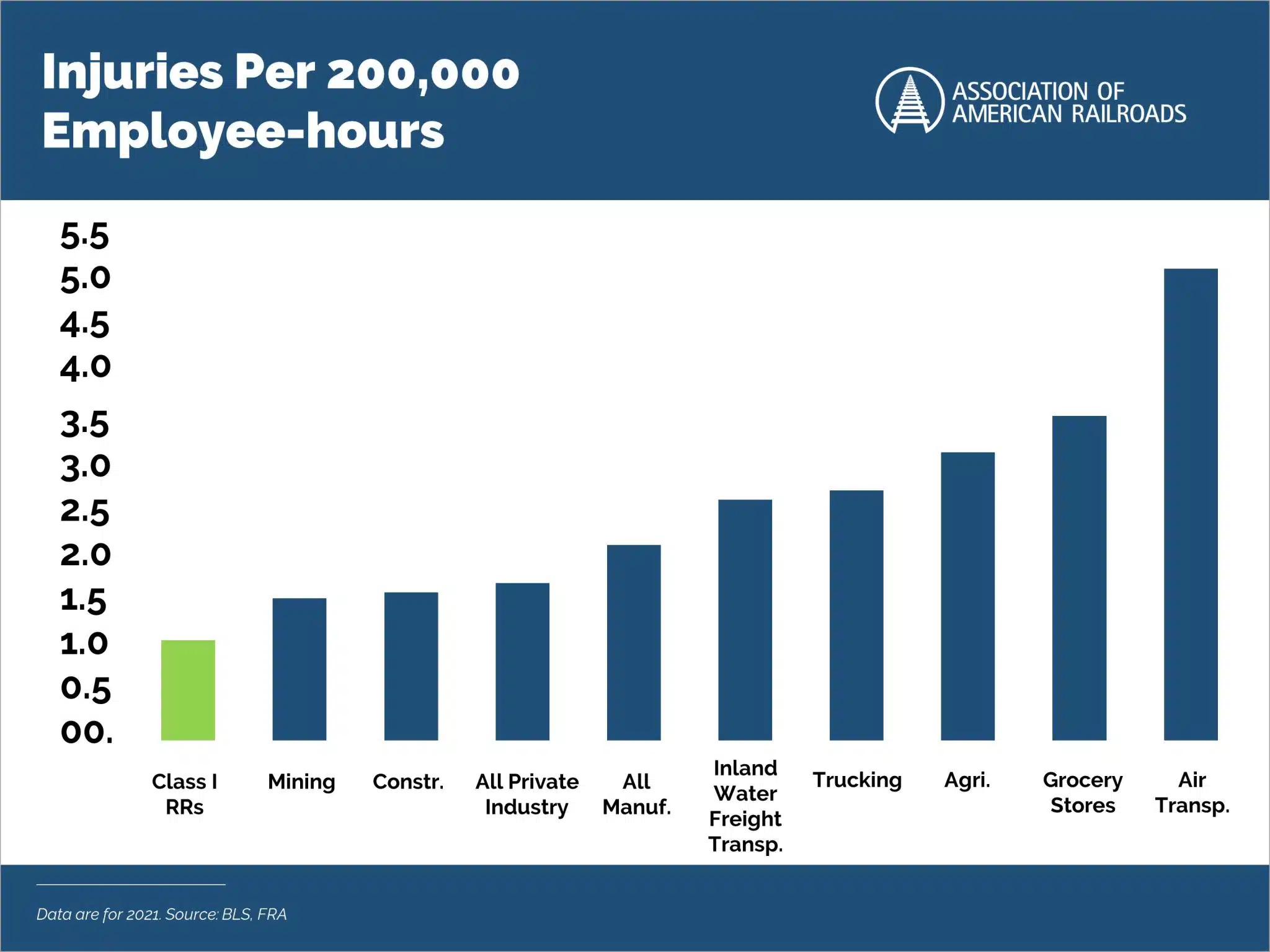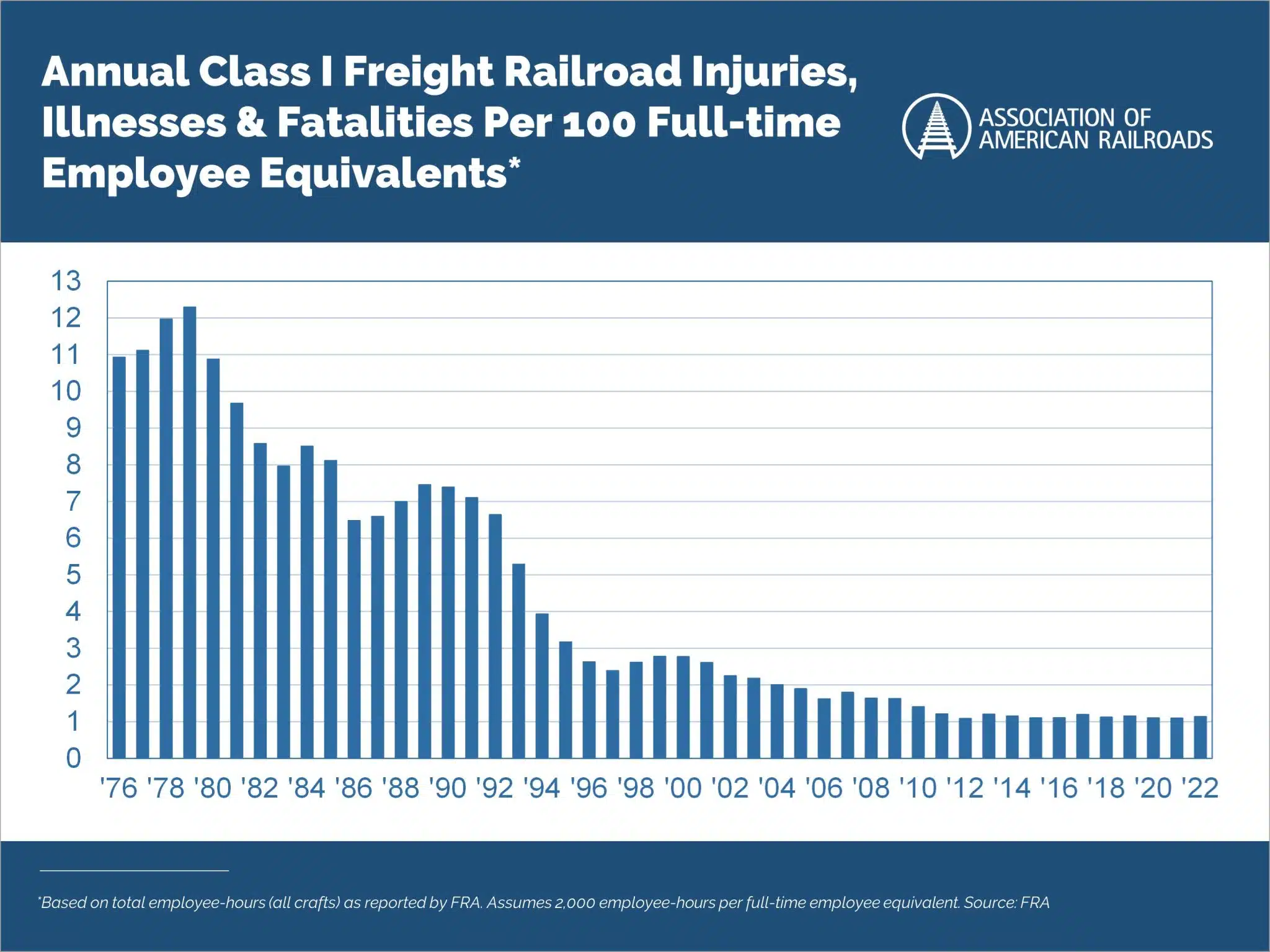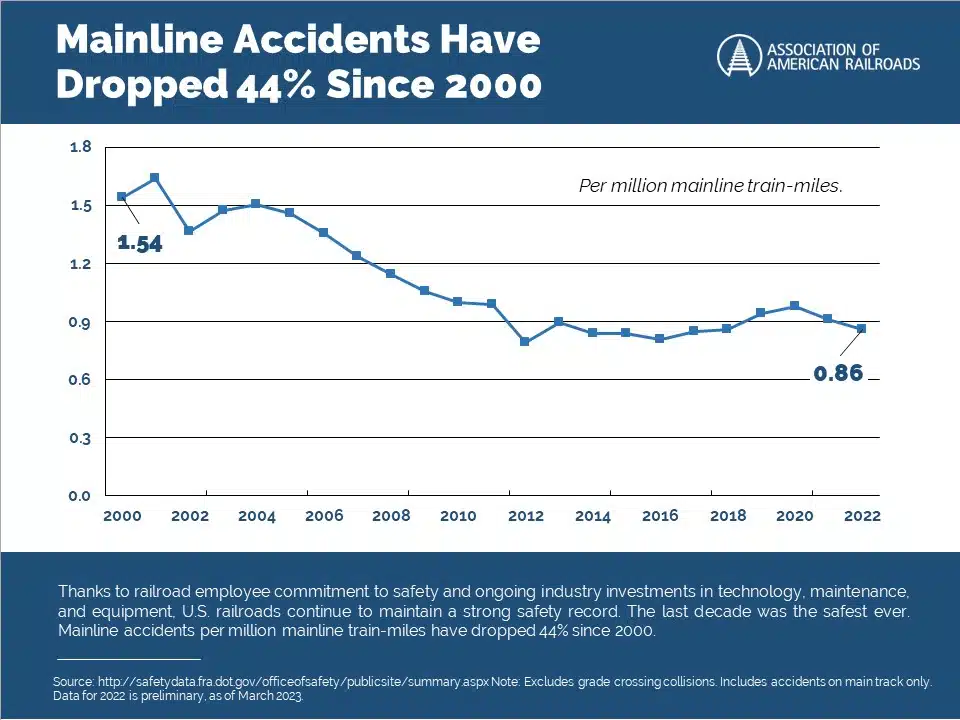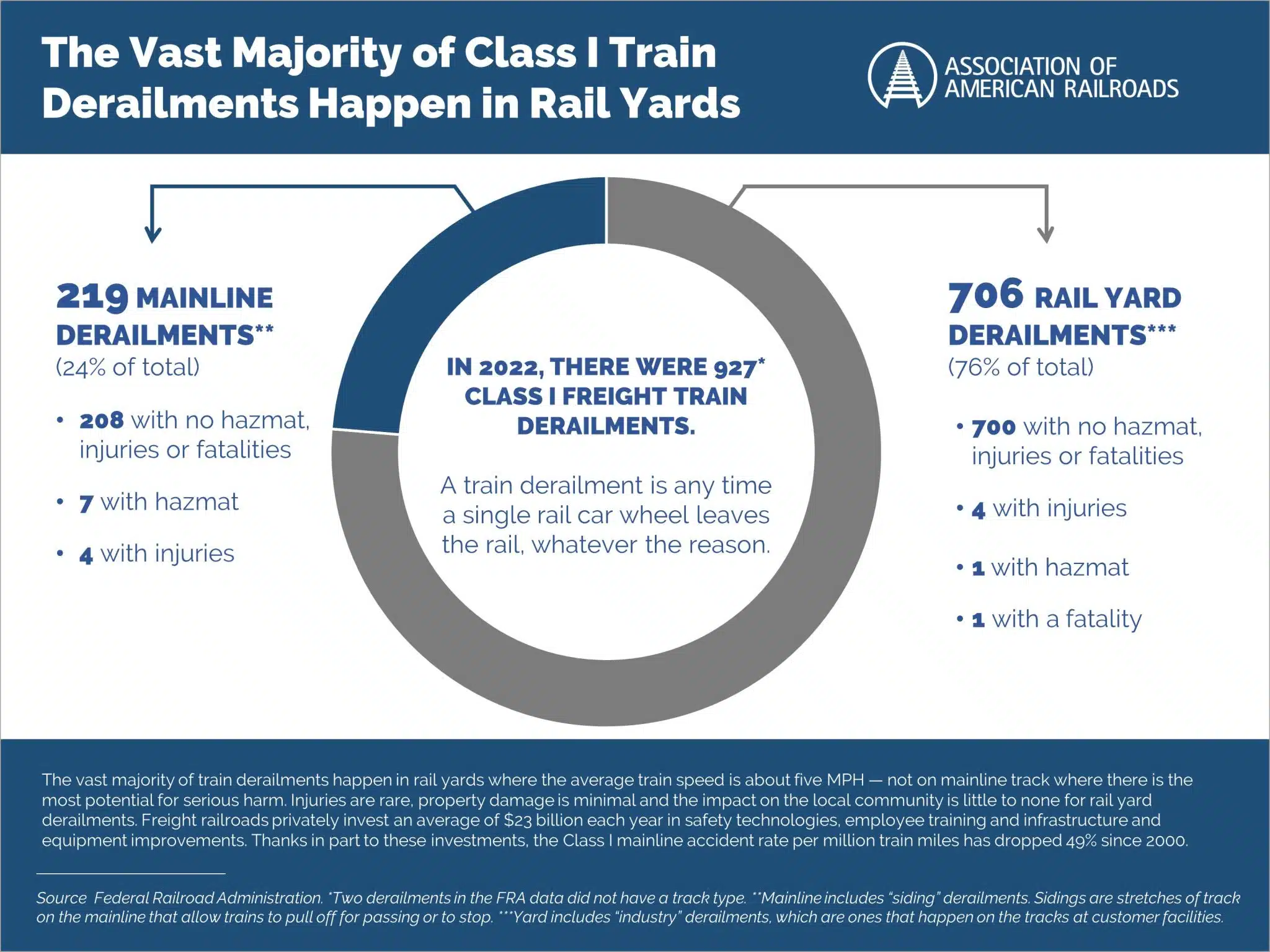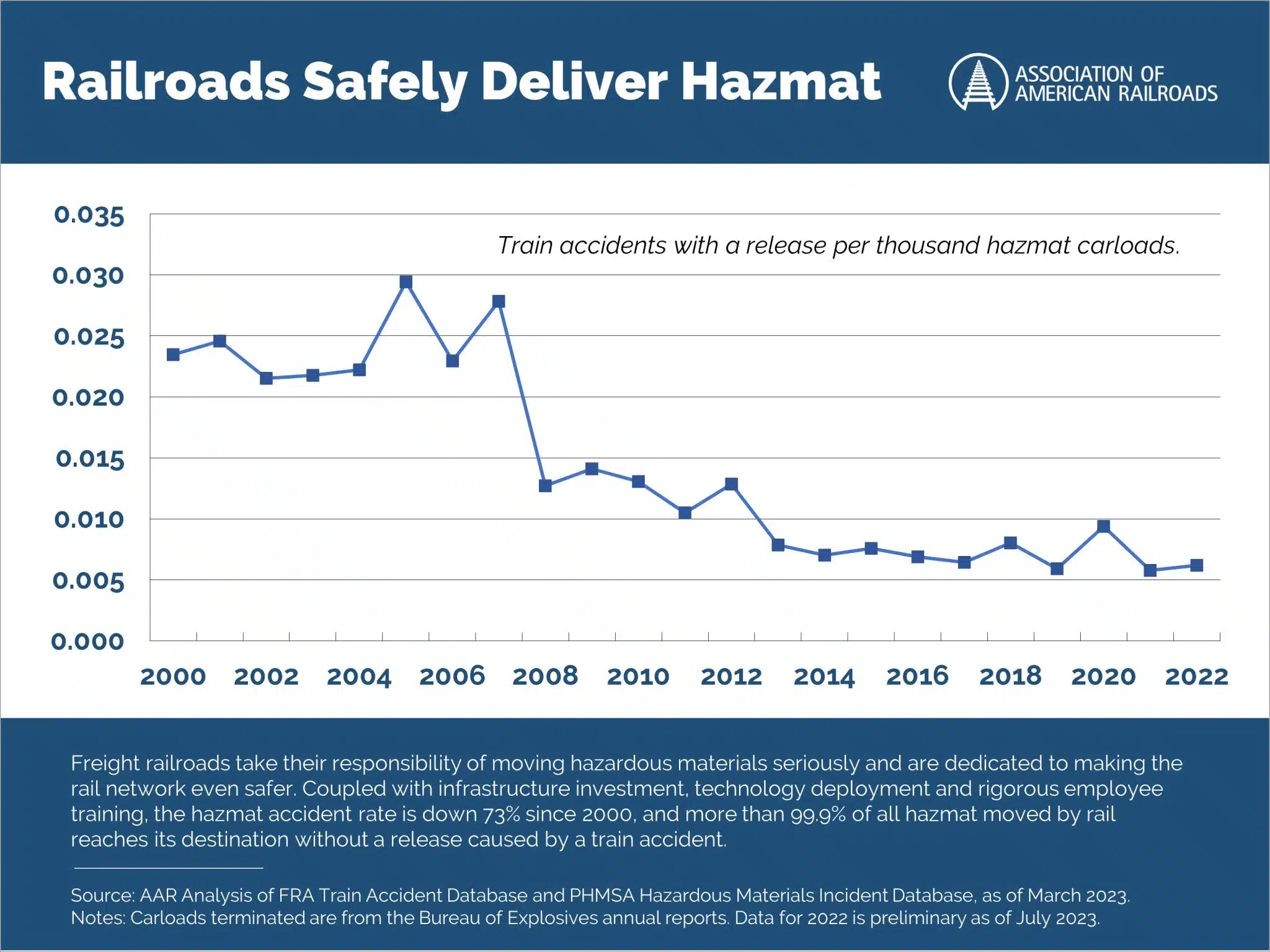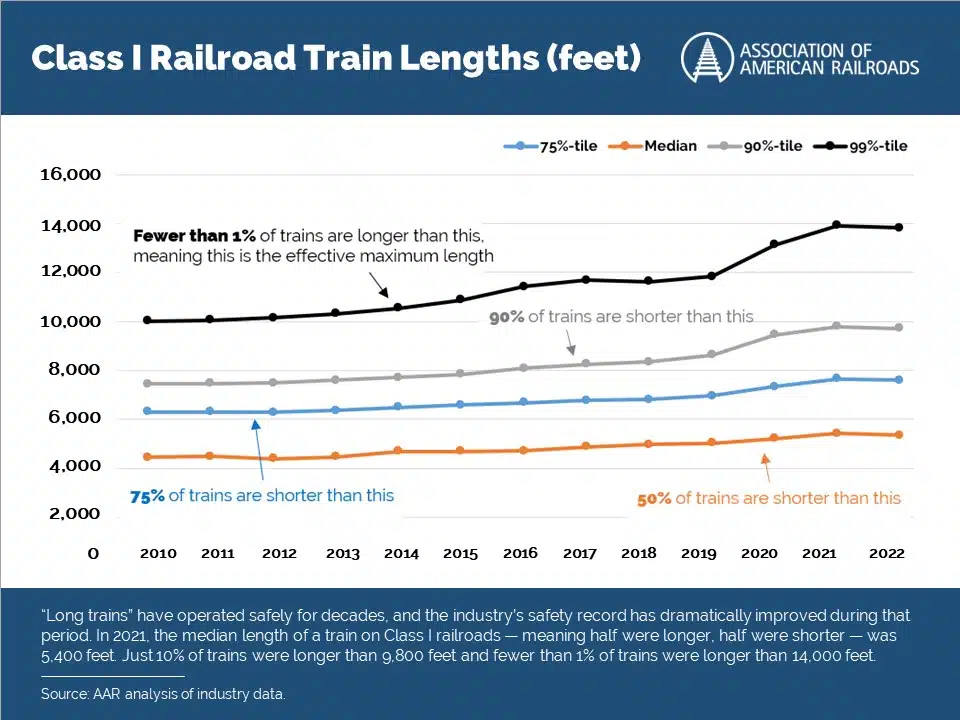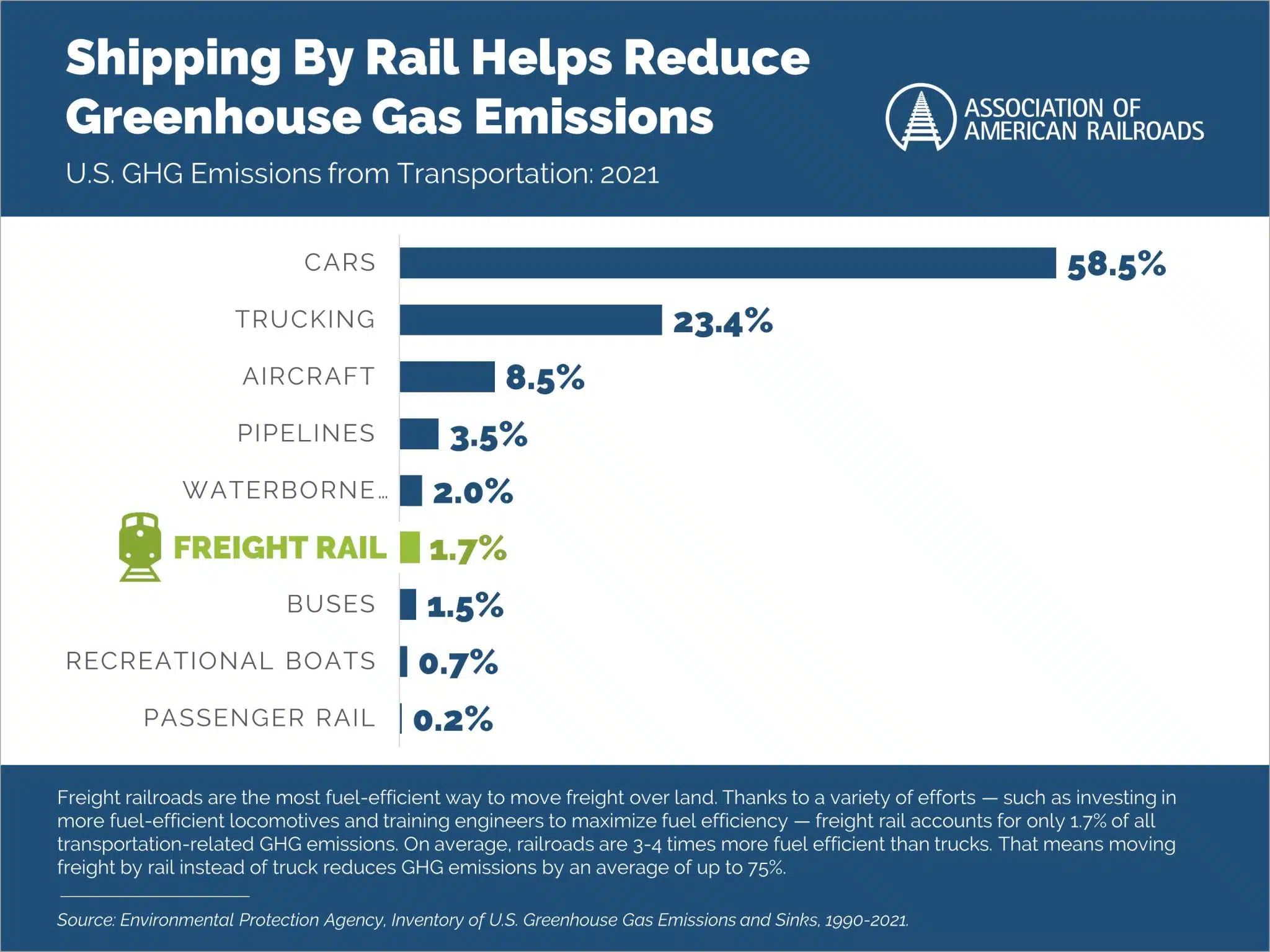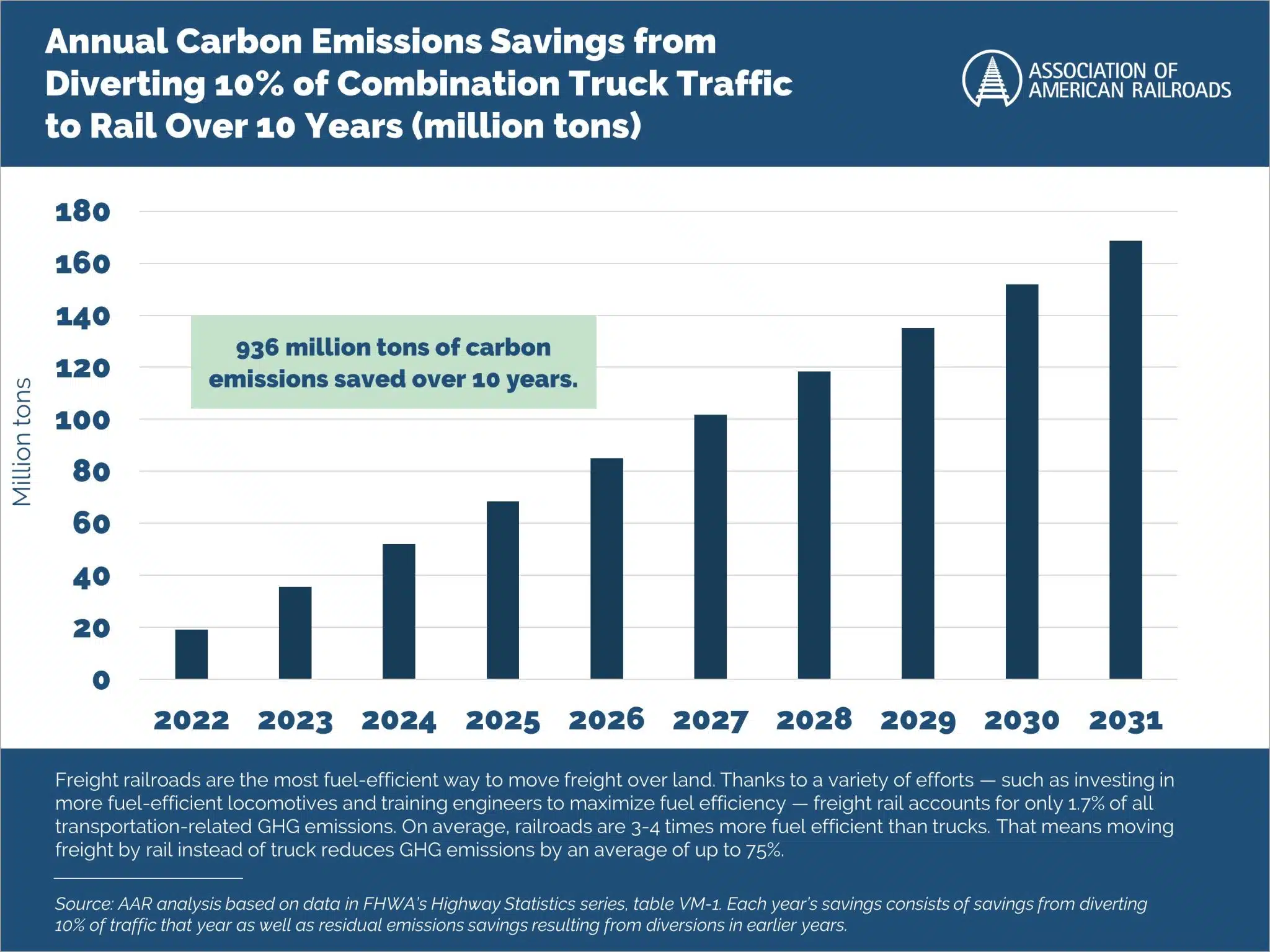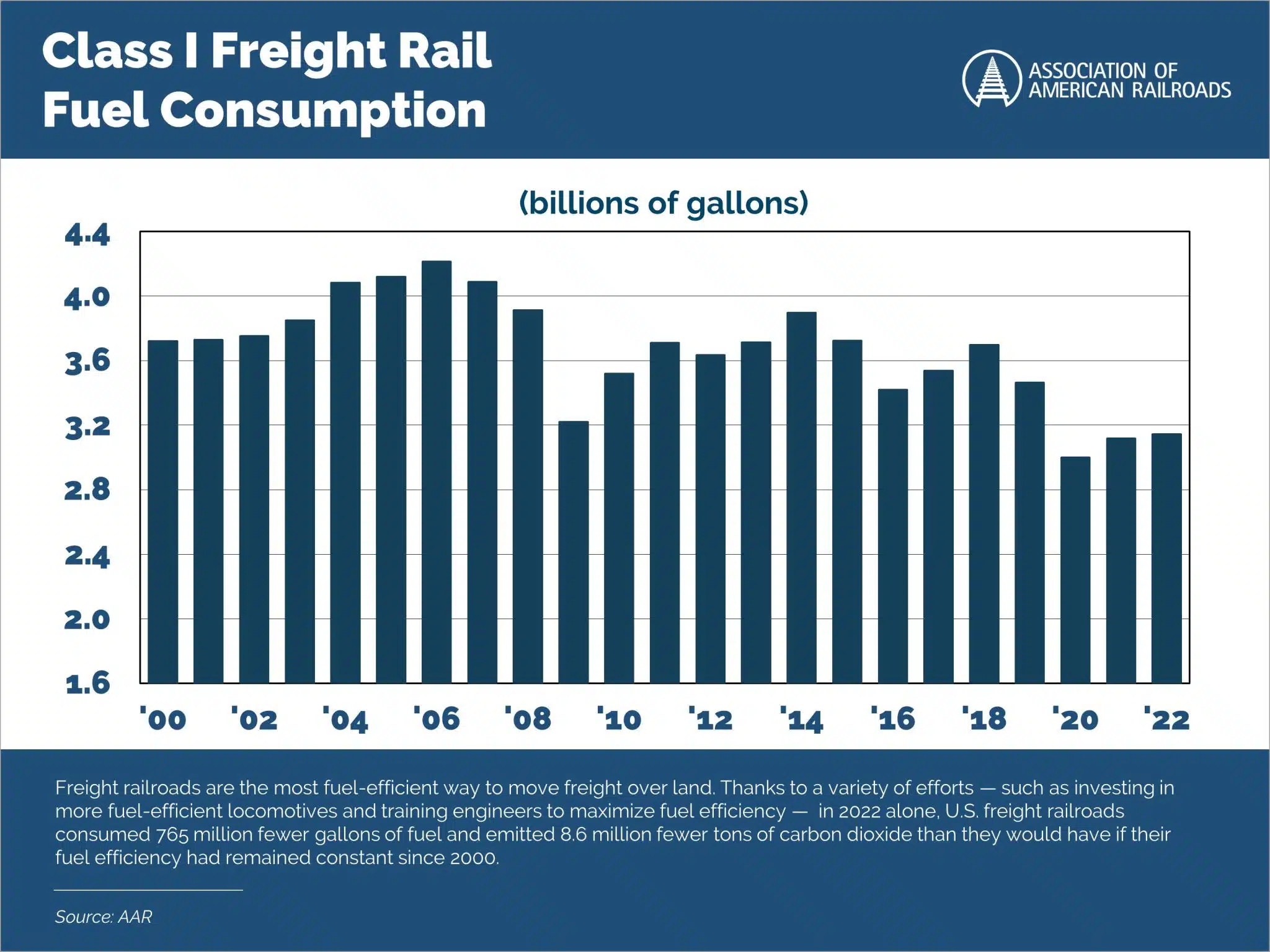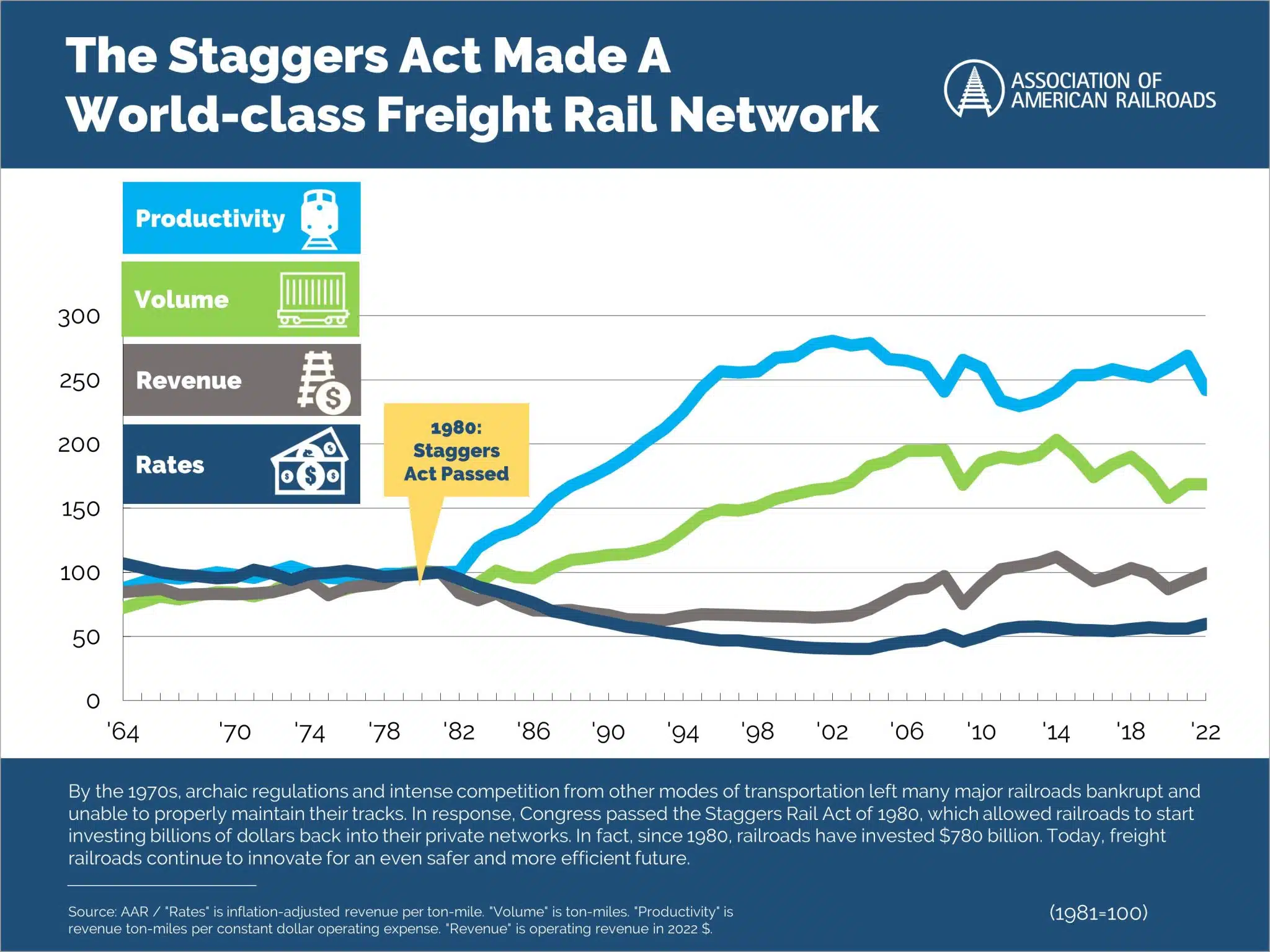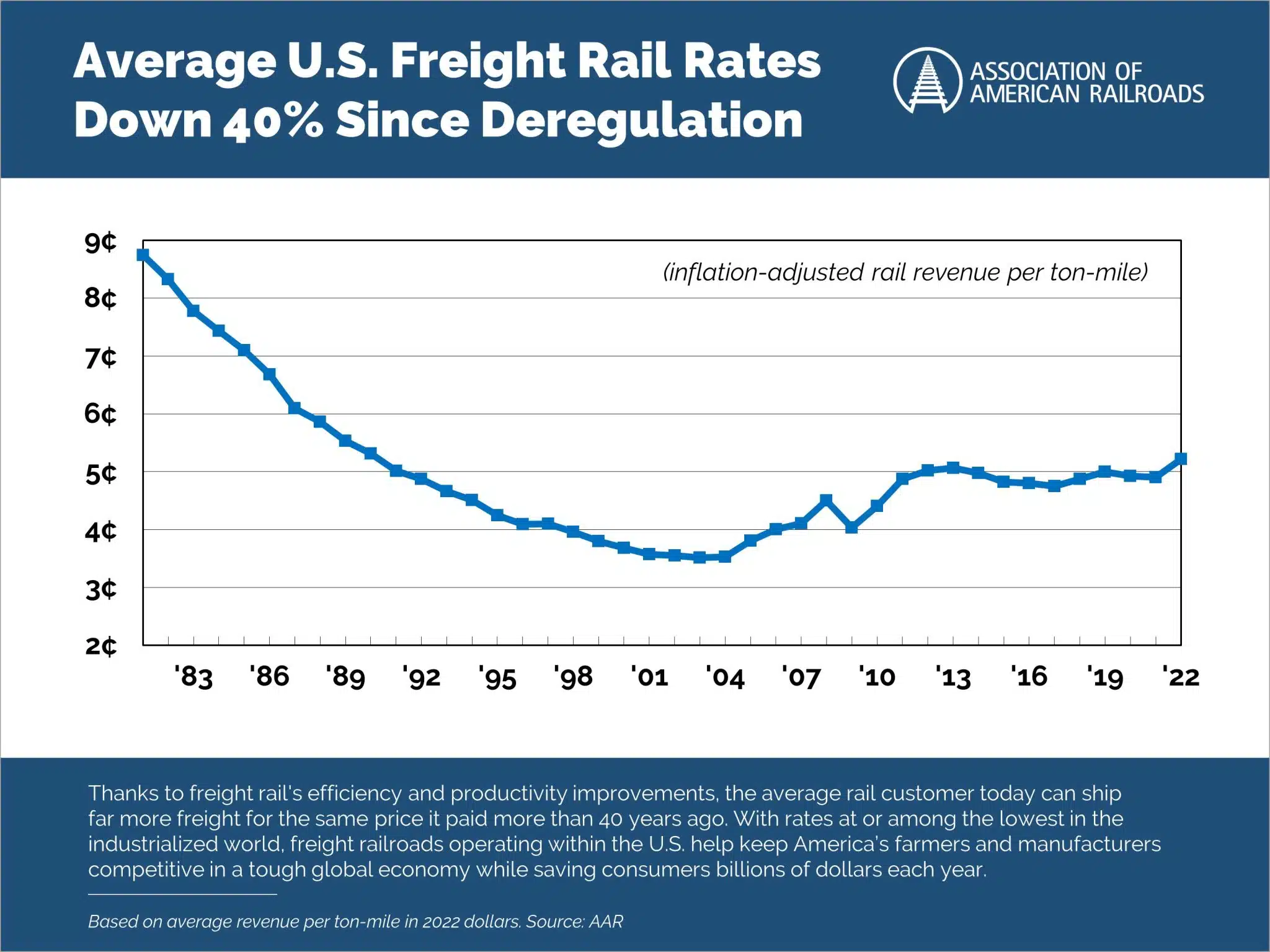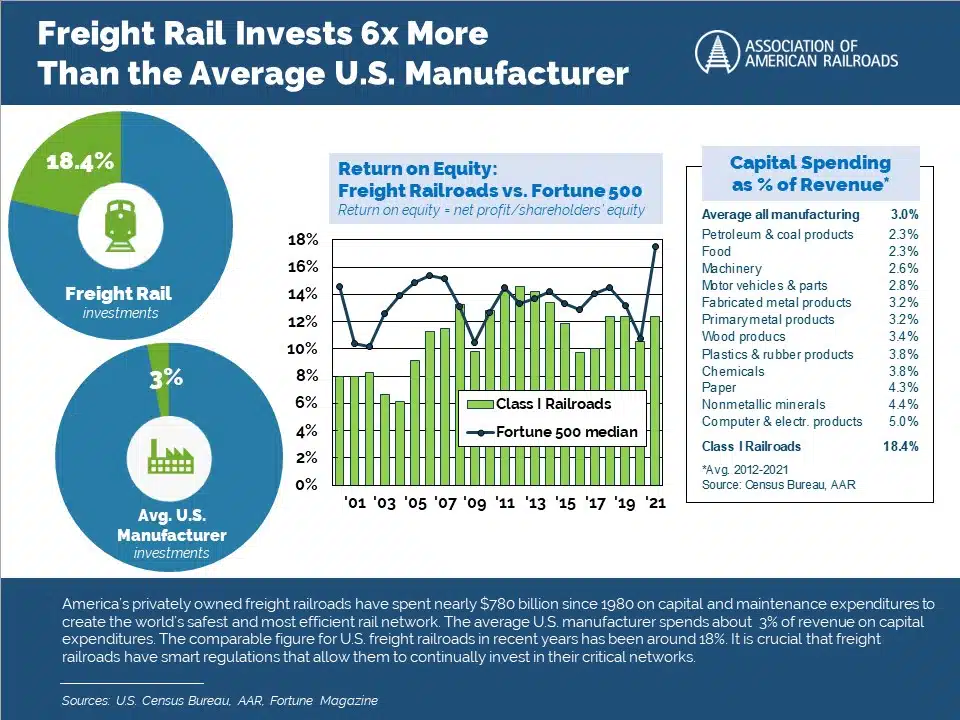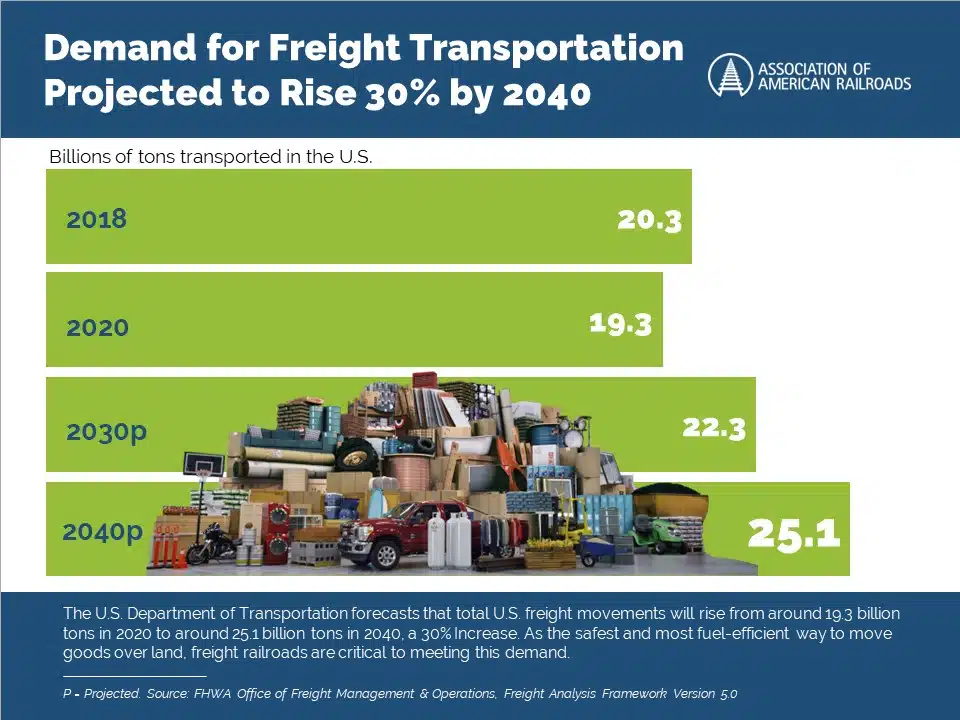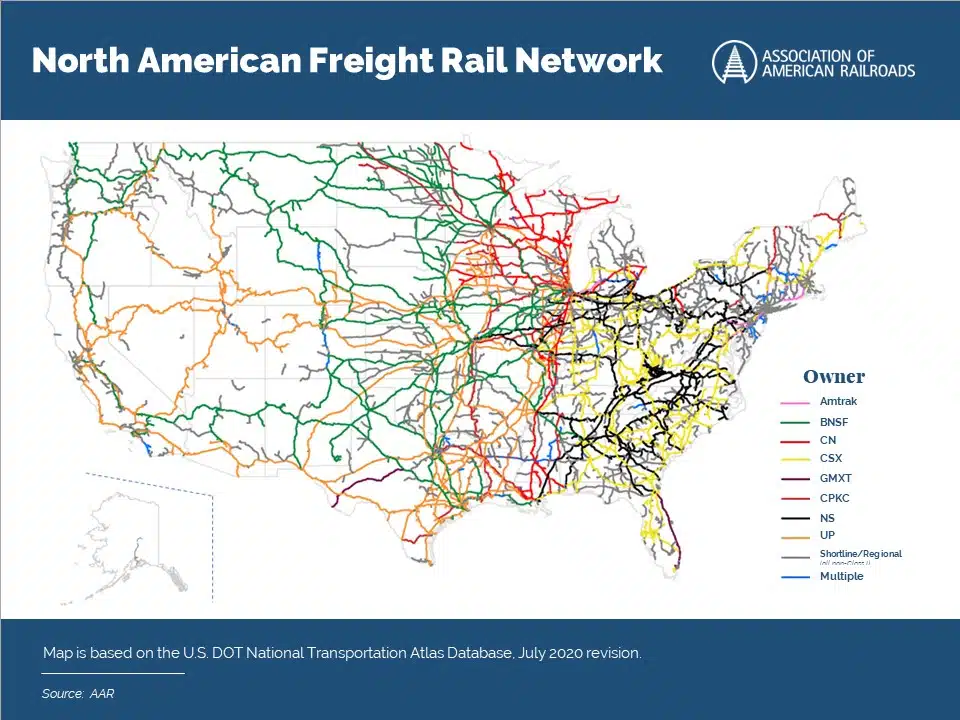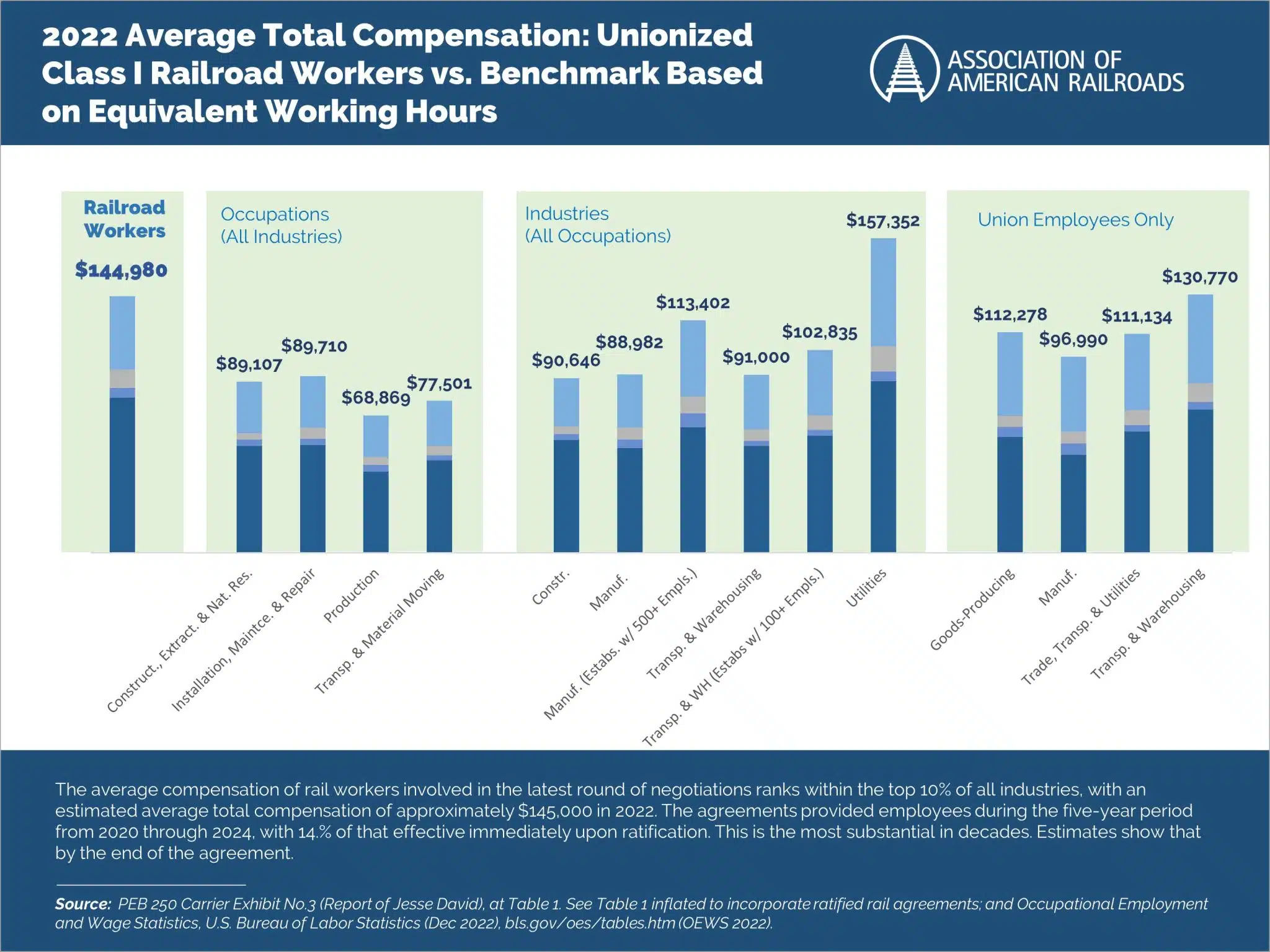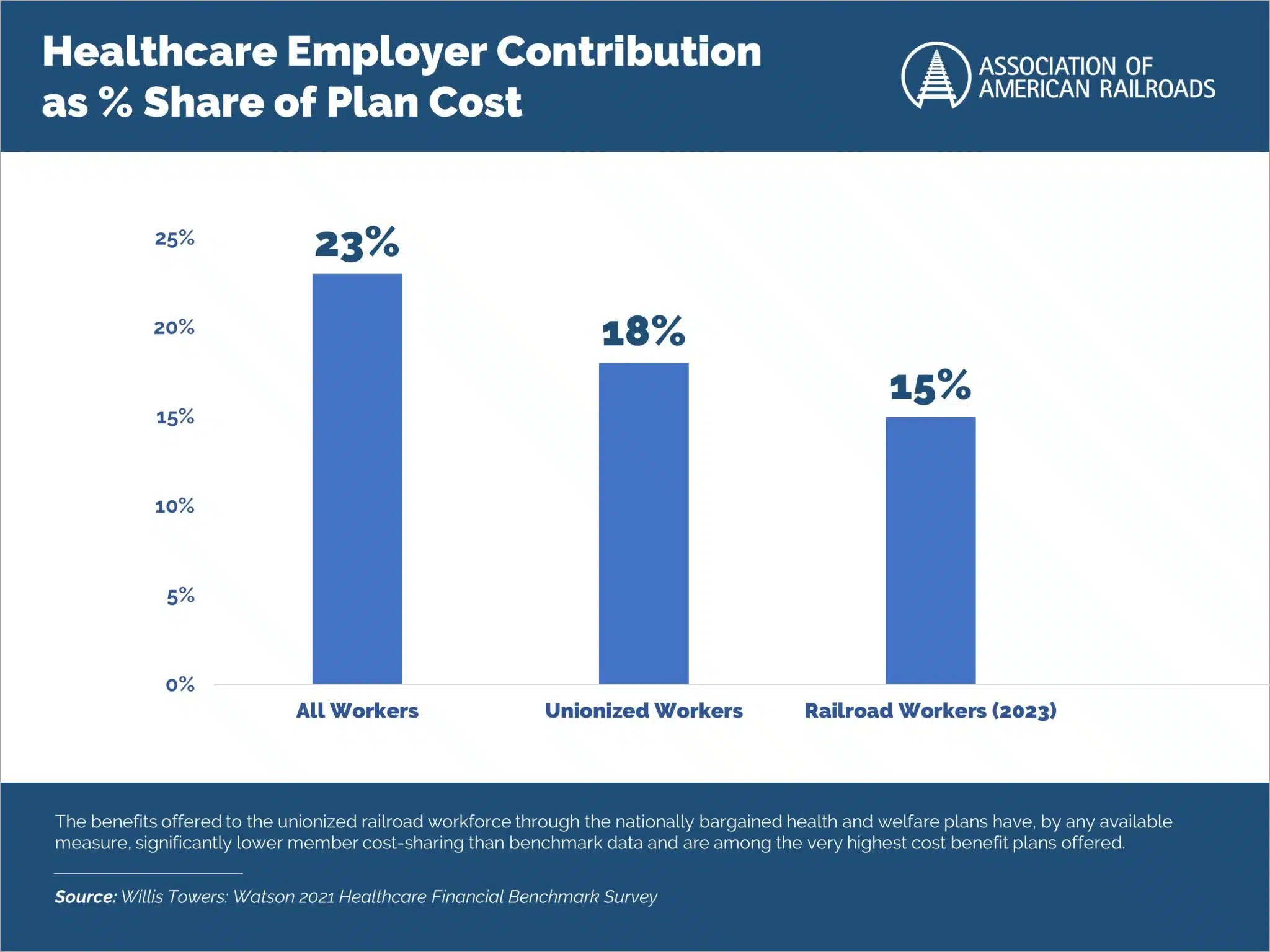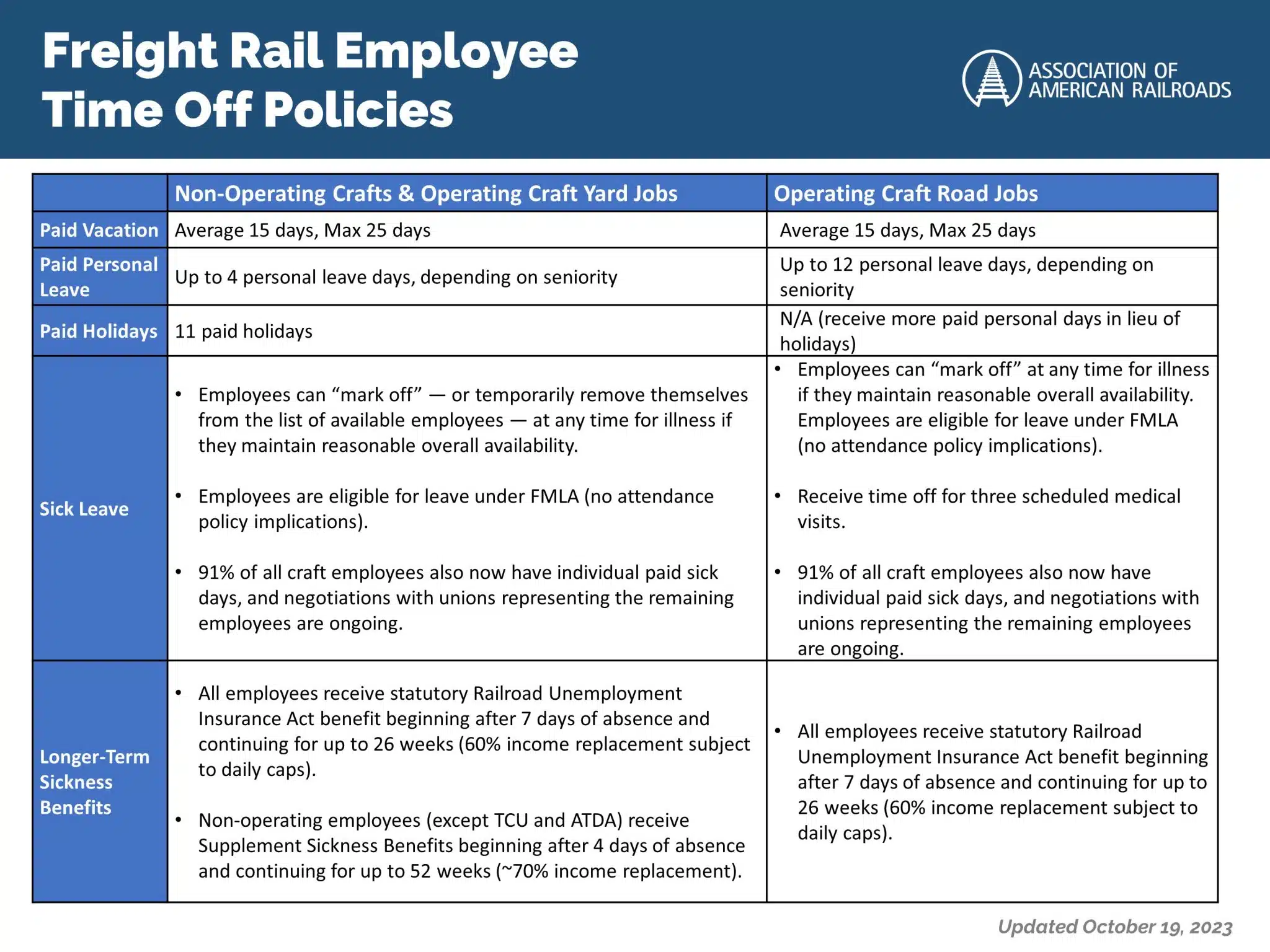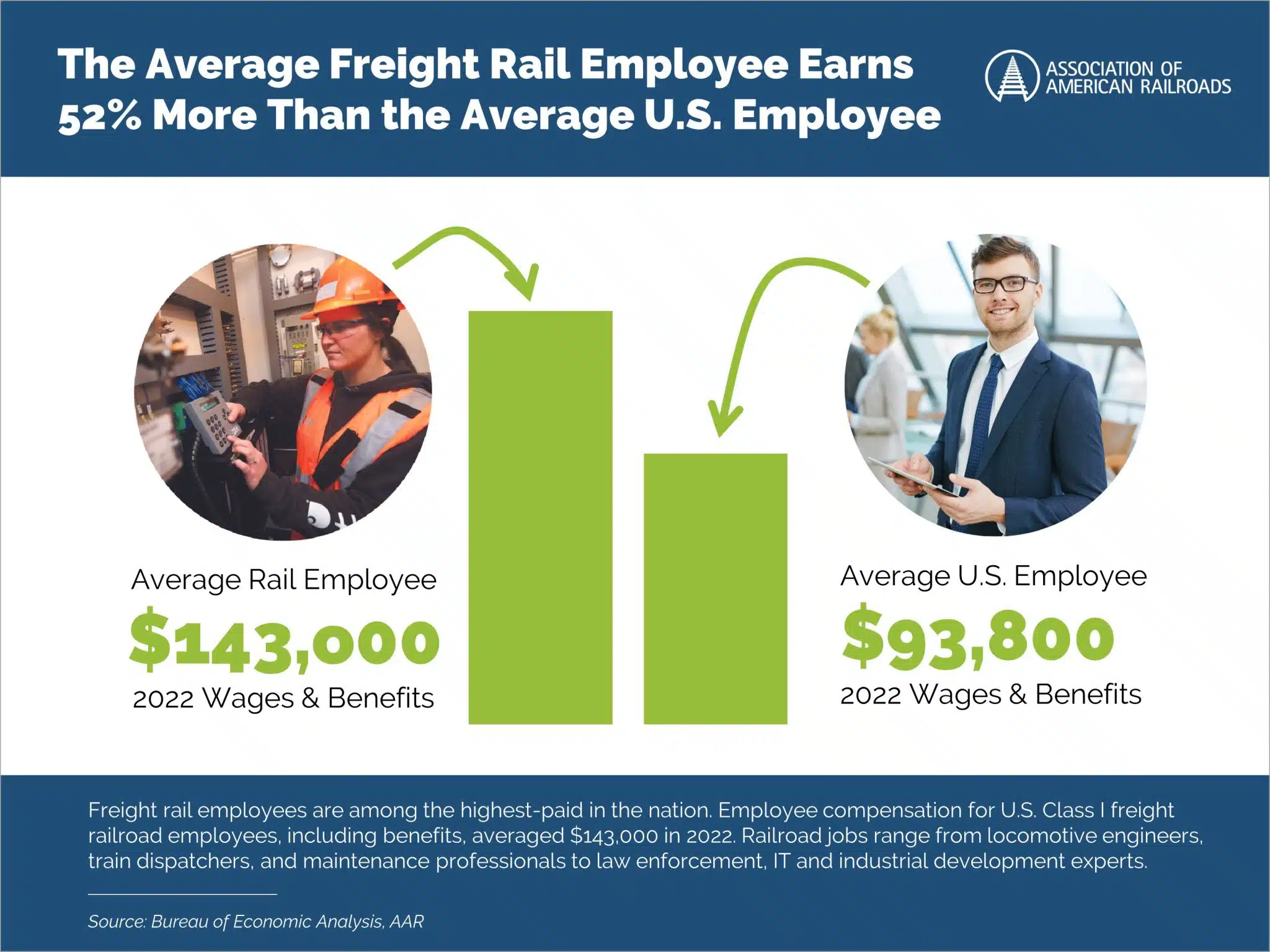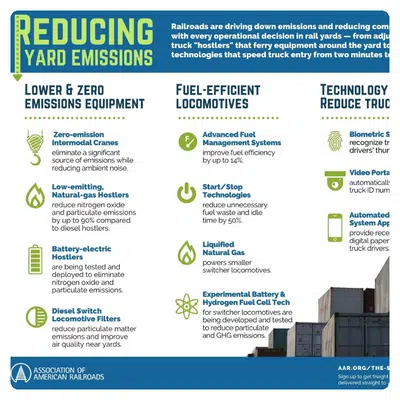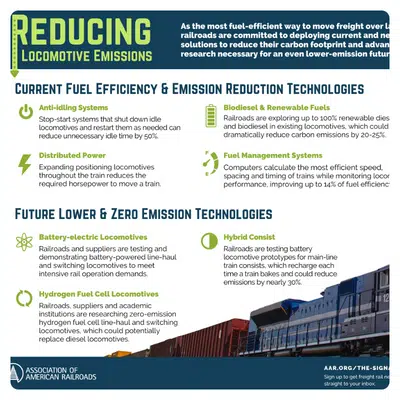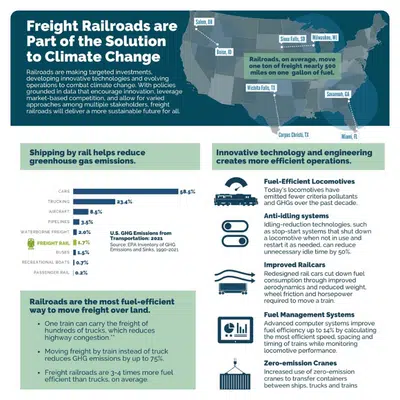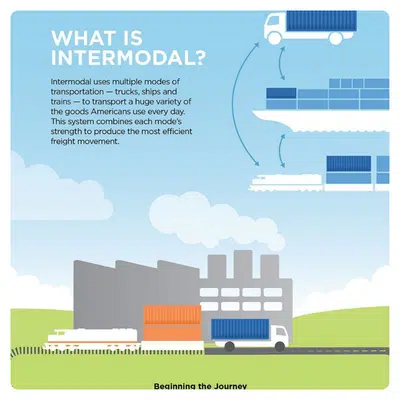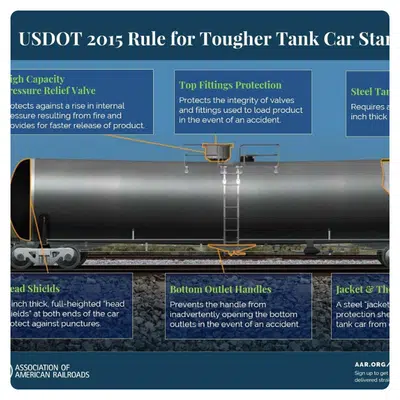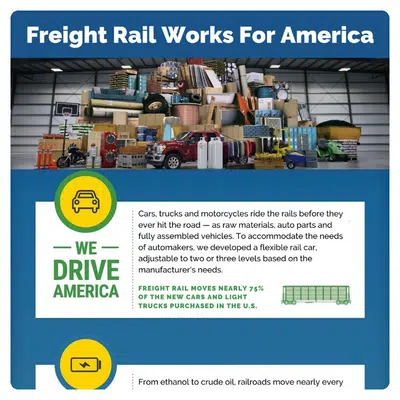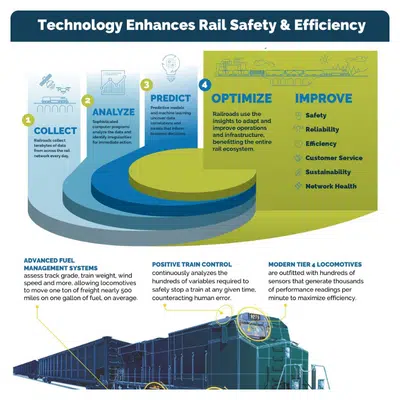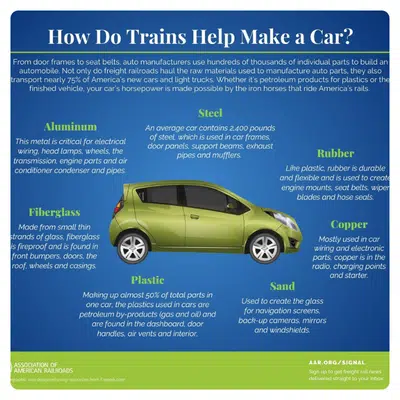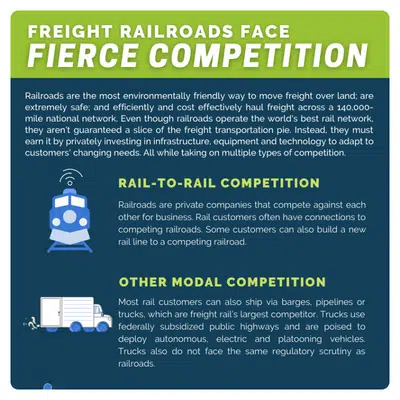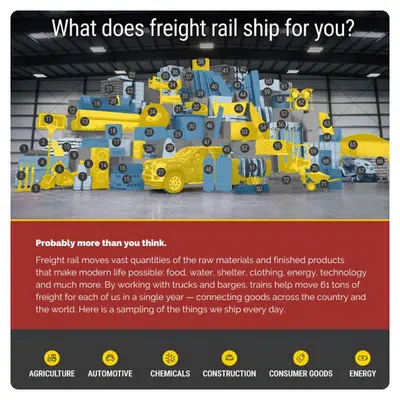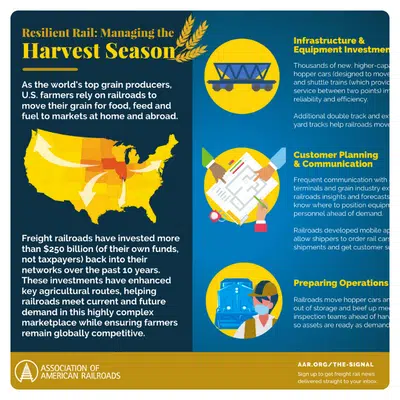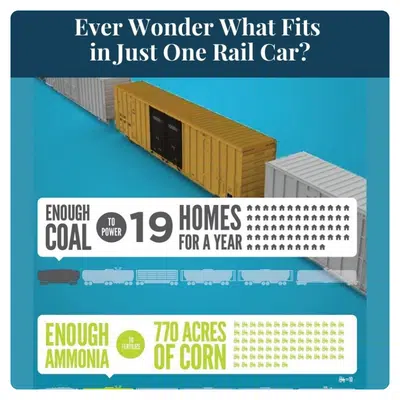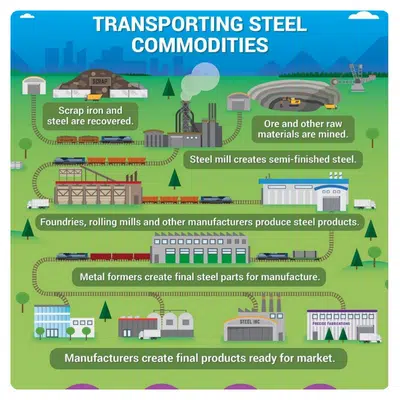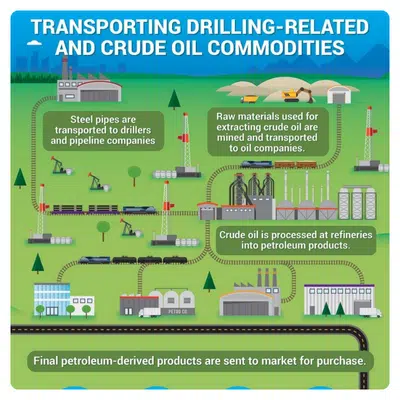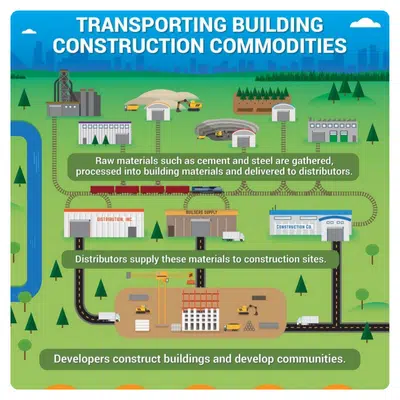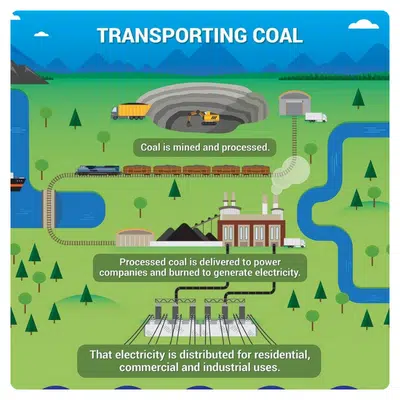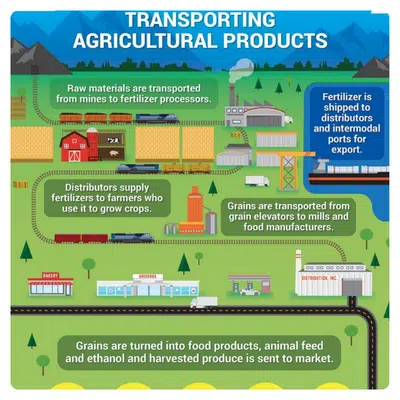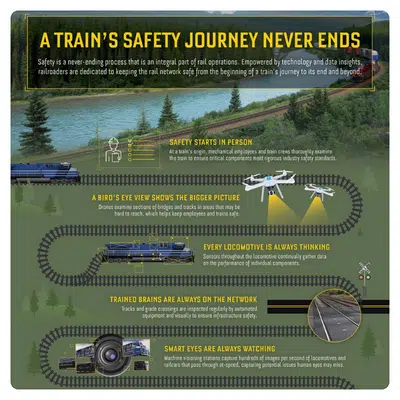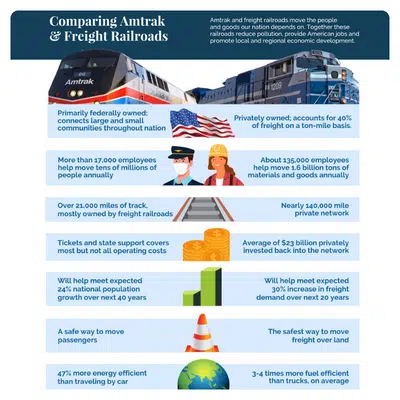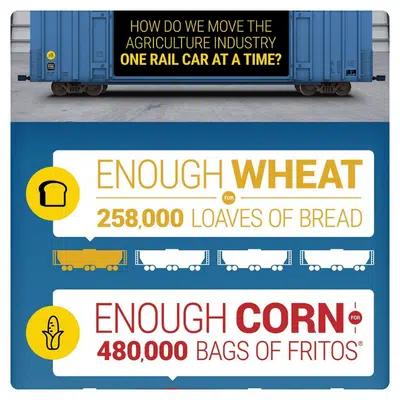Email AAR Policy & Economics with questions at policy@aar.org.
Provides financial information so stock analysts, economists, government agencies, and academics can analyze the health and efficiency of the railroads.
Information for each of the 49 states railroads operate in, including number of employees, route miles and top commodities.
Variety of AAR statistical products, which are free for AAR members and are available for purchase by non-AAR members through AAR’s online catalog.
Multiple indexes including All-Inclusive Index Less Fuel and Railroad Cost Recovery Index.
Access the fee-based circular letter library from MxV Rail (formerly Transportation Technology Center, Inc).
Information on AAR interchange rules, open top loading rules, standards and recommended practices and other technical topics.
Overall: In March 2023, freight railroads announced seven key safety measures to help drive accidents to zero, including installing approximately 1,000 new detectors, and they have kept those promises. Freight railroads are the safest way to move goods over land, and the last decade was the safest ever for U.S. railroads.
Hazmat: More than 99.99% of all hazmat moved by rail reaches its destination without a release caused by a train accident. Since 2000, the hazmat accident rate is down 75% to its lowest-ever rate.
Employees: For all railroads, on-duty fatalities declined 71% since 2000 and reached an all-time low in 2023. For Class I railroad employees, the rate of injuries and fatalities has dropped by 63% since 2000 reaching an all-time low in 2023.
Mainline, Track & Equipment: Since 2000, Class I railroads have reduced the mainline accident rate by 42%, the track-caused accident rate by 50% and the equipment-caused accident rate by 31%.
Grade Crossing: The grade crossing collision rate is down 25% last year compared to 2000 and the total number of public grade crossings has declined by 10% since 2005. However, along with trespass incidents, preventable accidents at grade crossings remain persistent challenges across the rail industry. Over 95% of rail-related fatalities are trespassers or grade crossing users.
Overall: From 1980 to 2022, America’s freight railroads, the vast majority of which are privately owned, spent approximately $780 billion — averaging well over $23 billion a year over the past five years — on capital expenditures and maintenance expenses related to locomotives, freight cars, tracks, bridges, tunnels and other infrastructure and equipment. That is the equivalent of 39 cents out of each revenue dollar between 1980 and 2022. It is $1 billion more than the historic investments Congress has made in 2021 in rail and multi-modal programs in the IIJA and the omnibus combined.
Infrastructure & Equipment: In the last 10 years, U.S. Class I railroads have spent more than $250 billion on infrastructure and equipment and have laid approximately six million tons of new rail. The American Society of Civil Engineers (ASCE) awarded America’s rail network the highest grade in its last two report cards.
Manufacturing Comparison: The average U.S. manufacturer historically spends about 3% of revenue on capital expenditures. The comparable figure for U.S. freight railroads between 2012 and 2021 averaged more than 18% or six times higher.
Overall: Freight railroads account for roughly 40% of U.S. long-distance freight volume (measured by ton-miles) — more than any other mode of transportation. However, they account for just 0.5% of total U.S. greenhouse gas emissions, according to EPA data, and just 1.7% of transportation-related greenhouse gas emissions.
Fuel Efficiency: Railroads are the most fuel-efficient way to move freight over land, moving one ton of freight nearly 500 miles per gallon of fuel, on average. On average, railroads are three to four times more fuel-efficient than trucks. A single freight train can replace several hundred trucks.
Locomotives: Today’s fuel-efficient locomotives have emitted fewer criteria pollutants and GHGs over the past decade. Idling-reduction technology, such as stop-start systems, can reduce unnecessary idle time by 50%. Advanced software improves fuel efficiency by up to 14% by calculating the most efficient speed, spacing and timing of trains.
Trucks: Greenhouse gas emissions are directly related to fuel consumption. That means moving freight by rail instead of truck lowers greenhouse gas emissions by up to 75%, on average. If 10% of the freight shipped by the largest trucks were moved by rail instead, greenhouse gas emissions would fall by more than 20 million tons annually. That’s the equivalent of removing 4.0 million cars from our highways or planting 300 million trees.
Fuel Consumption: In 2022 alone, U.S. freight railroads consumed 765 million fewer gallons of fuel and emitted 8.6 million fewer tons of carbon dioxide than they would have if their fuel efficiency had remained constant since 2000. If railroads did not move freight in the United States, it would take over 83 million additional trucks traveling on public roadways and would take about four times more fuel than rail to handle the freight Americans rely on every day.
Overall: Freight rail employees are among the highest paid in the nation. In 2022, U.S. Class I freight rail employees earned an average annual compensation of $143,000, including wages and benefits.
Hiring: Railroads also continue to aggressively hire. Total Class I rail employment was 122,941 in March 2024. Total T&E employment in March 2024 was 52,910, up 43 over February 2024 and the most since December 2019. March 2024 was the sixth straight month-to-month gain in T&E employment.
Unions: Approximately 85% of Class I rail employees are unionized, and rail employees are represented by one or more of a dozen different labor unions. The Railway Labor Act governs collective bargaining between freight railroads and their employees.
The average compensation of rail workers involved in the latest round of negotiations ranks within the top 10% of all industries, with an average total compensation of more than $126,000 in 2020. The final contracts will provide employees with a 14.1% wage increase effective immediately and a 24% wage increase by 2024, the most substantial in decades. Estimates show that by the end of the agreement, the average rail worker’s total compensation will reach about $160,000 per year. The agreements will also provide about $16,000, on average, in immediate payouts to unionized Class I freight rail employees.
Vacation: The average unionized Class I freight rail employee currently receives three weeks of paid vacation and up to 14 days for personal leave. More senior employees receive up to seven weeks of paid vacation.
Sick Leave: As of October 19, 2023, the majority of the unions at the NCCC carriers, representing 91% of all craft employees, now have individual paid sick leave days in addition to pre-existing short- and long-term paid sickness benefits already in effect across the industry.
Retirement: Rail industry employees are covered by the Railroad Retirement System, which is separate from social security and is funded by railroads and their employees. In 2021, nearly 500,000 beneficiaries received retirement and survivor benefits totaling $13.4 billion from the system.
Overall: The freight rail network is nearly 140,000 miles. There are six Class I railroads (railroads with revenue of at least $900 million) and approximately 615 short line railroads (Class II and III). Short lines and Class I railroads. Class I railroads account for around 67% of freight rail mileage, 87% of employees and 94% of revenue. Freight rail accounts for around 40% of long-distance ton-miles — more than any other mode of transportation.
States: Railroads operate in 49 states and the District of Columbia, with short lines running over about 44,000 route miles and Class I railroads running over about 92,000 route miles.
Amtrak: Amtrak owns 623 route miles (primarily in the Northeast) and operates, maintains, and dispatches another 229 route miles in Michigan and New York. The vast majority of the remaining 96% of Amtrak’s more than 21,400-mile system consists of tracks owned and maintained by freight railroads. More than 70% of the miles traveled by Amtrak trains are on tracks owned by other railroads.
Demand: The Federal Highway Administration forecasts that total U.S. freight movements will rise from around 19.3 billion tons in 2020 to 25.1 billion tons in 2040 — a 30% increase.
Chicago: For 150 years, Chicago has remained the nation’s busiest rail hub. All six U.S. Class I railroads operate there, as do many non-Class I railroads. Approximately one in four rail carloads and intermodal units originate, terminate or pass through the Chicago area.
Rates: Since the Staggers Act was passed in 1980, average rail rates adjusted for inflation have fallen 40%. This means the average rail shipper can move much more freight for the same price it paid more than 40 years ago.
Overall: Freight rail is part of an integrated network of trains, trucks and barges that ships around 61 tons of goods per American every year. In a typical year, freight railroads haul around 1.6 billion tons of raw materials and finished goods. Redesigned railcars have helped increase average tonnage. In 2022, the average freight train carried 4,089 tons, up from 2,923 tons in 2000.
Agricultural & Food Products: In a typical year, railroads haul around 1.6 million carloads of grain and other farm products, more than 1.7 million carloads of food products, and several hundred thousand carloads of fertilizers and the raw materials that go into making them. Railroads typically carry more than 60,000 carloads of food and agriculture products per week. One railcar can carry enough: Flour for about 258,000 loaves of bread, or Corn for the lifetime feeding of 37,000 chickens or Barley for about 94,000 gallons of beer or Soybeans for about 400,000 pounds of tofu.
Grain: The United States is the world’s largest grain producer. Railroads account for well over a third of U.S. grain export movements, according to the USDA. In 2022, U.S. Class I railroads moved 1.5 million carloads of grain. Corn is by far the highest-volume grain carried by railroads. As of early 2023, the North American railroad grain car fleet consisted of around 273,000 cars (owned by railroads and non-railroads) with a 1.4 billion cubic feet capacity.
Chemicals: Freight railroads moved 2.3 million carloads of plastics, fertilizers and other chemicals in 2022. Chemicals help clean our water, fertilize our farms, package our food, build our cars and homes, protect our health, and enhance our well-being in thousands of other ways. One rail tank car of anhydrous ammonia carries the equivalent of around four tanker trucks and enough to fertilize 770 acres of corn.
Coal: Freight railroads moved 3.4 million carloads of coal in 2022. While rail coal volumes have declined in recent years, railroads account for around 70% of U.S. coal deliveries to power plants. One rail car can carry enough coal to power 20 homes for a year.
Construction, Pulp & Paper: Freight railroads move around three million carloads of construction-related materials in a typical year. One rail car to carry as much crushed stone, sand and gravel as five trucks. The pulp and paper industry is one of the largest industries in the world. In a typical year, America’s freight railroads carry around 700,000 carloads of pulp and paper products.
Crude Oil: In 2022, the average carload of crude oil originated in the United States carried around 650 barrels of oil. Based on that, the 68,000 carloads of crude oil originated by U.S. Class I railroads in 2022 was equivalent to around 121,000 barrels per day, or approximately 1.0% of U.S. production. One rail carries enough crude oil to make approximately 13,500 gallons of gasoline.
Intermodal: In 2022, U.S. rail intermodal volume was 13.5 million units, and intermodal accounted for approximately 27% of revenue for major U.S. railroads, more than any other single rail traffic segment. It’s been the fastest-growing major rail traffic segment over the past 25 years. Around half of rail intermodal volume consists of imports or exports, reflecting the vital role intermodal plays in international trade.
Motor Vehicles & Parts: Freight railroads are part of every production stage of an automobile — from moving raw materials and auto parts to delivering a finished car or truck to dealerships across the nation. Freight railroads carry 1.8 million carloads in a typical year. With a single train capable of carrying hundreds of cars, freight rail transports around 75% of the new cars and light trucks purchased in the U.S. Despite pandemic-related shortages, in 2022, automakers sold nearly 14 million new cars and light trucks in the United States, an achievement made possible in large part by freight railroads.
In a new white paper, AAR outlines how railroads are taking decisive, meaningful steps to build a safer future. Among other things, the paper examines how carriers employ a multi-faceted strategy to safeguard its workforce and the public by addressing and mitigating the leading causes of accidents.
Read AAR’s updated climate change report to see the policy strategies we encourage policymakers to embrace, including encouraging modal shift, supporting innovative technology solutions and allowing for varied approaches.
Released every four years, the American Society of Civil Engineers (ASCE) awarded America’s rail network the highest grade — a B — in its most recent report. The high marks for America’s privately funded freight rail system stand in stark contrast to taxpayer-funded transportation infrastructure.

